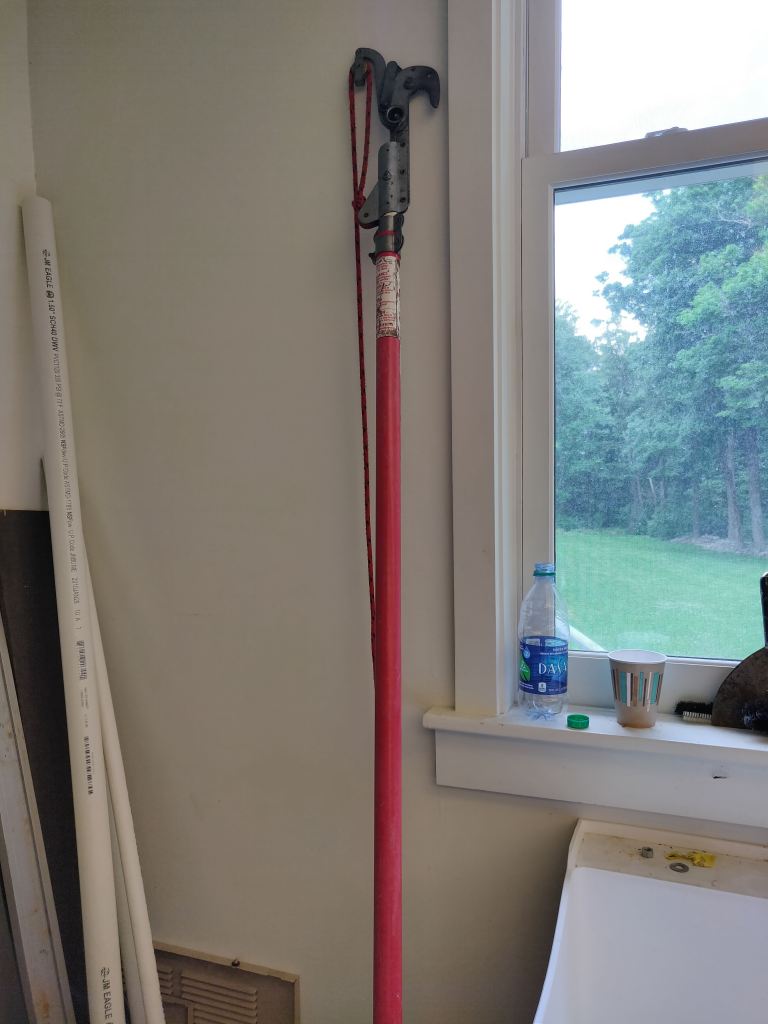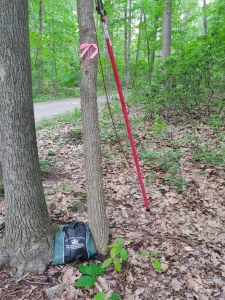Did you know that there’s a shrub relative of roses that has thorns on the underside of its leaves? I learned this today while cutting the leaves off of a couple of branches of that very species. Or, I should say, attempting to cut the leaves off… because the leaves bit back.
There’s a lot of “biting back” in my field work, from thorny branches poking me as I collect leaves, to bushes tripping me up as I venture through off-trail parts of the woods, to clippers in the back pocket of my work jeans literally biting into my back. But experience has taught me to prepare for it as much as I can, by bringing a full kit of science and non-science supplies when I go out looking for trees. That brings me to this week’s research methods post: what’s in my backpack?
Here’s my backpack and all of its contents:

Taken after I returned from collecting black gum this afternoon
- Peterson Field Guide to Eastern Trees. A field guide is essentially a small, portable encyclopedia on a specific topic. Field guides to plants (also called floras) tend to include two sections: plates, with drawings of different leaves side-to-side for species comparisons, and text descriptions, including details of each species’ general location, bark, flowers, and other identifying info. I rely on this field guide religiously, especially if I’m looking for something I haven’t collected before (see: all the sticky notes on the side of the book marking off species I want to find). But I use it in conjunction with other resources, such as photos from online encyclopedias, samples from Black Rock’s herbarium, and knowledge of the forest’s staff.
- Book of poetry by Allen Ginsberg. There’s no scientific use to this one – I just carry it around in case I need a breather and want reading material. I am an English nerd as well as a budding biologist, after all. My all-time favorite poem, “Poem Rocket,” is in this book.
- My own notebook. A good scientist would buy a new notebook to devote entirely to a project such as mine. I am awful at compartmentalizing, however, so I just use the same notebook in which I write subway poems, fanfiction drafts, and other notes for recording tree data and observations. Most of my sampling notes are taken on the Avenza app these days. Still, I like to keep the paper notebook with me just in case (and it’s useful if I’m ever compelled to stop and write.)
- Water bottle. This one is self-explanatory. Gotta stay hydrated!
- Bug spray. Ben, one of the forest maintenance staffers at Black Rock, always tells me that I shouldn’t wear bug spray. “Just use unscented soap,” he says. “You’ll earn the respect of the mosquitoes, and they’ll leave you alone.” But I am a mere mortal, not a forest spirit like him. And anyway, I seriously doubt I could find unscented conditioner that works for my hair type.
- Sunscreen and sunglasses. I rarely use these because, between trails and going off-road, most of my work happens in the shade. Plus, since I wear long pants and a hat when I’m searching for samples, the only body part vulnerable to sun is my shoulders and arms. I keep them around nevertheless. (Fun fact: my dad got these sunglasses at a conference; the orange parts read, “Big Data Finance.”)
- Black Rock Forest trail map. Rarely used for actual navigation, now that I have the same map on my phone and can actively track my location on it using Avenza. Rather, this map is very useful when I need a small, flat surface upon which to write a label. And it would be very necessary if (god forbid) my phone ever died while I’m in the field.
- Trail snacks. I usually venture out on sampling trips in late morning and plan to have lunch after I return to the Science Center. But often, finding the trees I seek takes longer than I expect, and I need to refuel before starting to walk back. My favorite trail snacks are apples, granola bars, and salted almonds (all of which keep well in the heat.)
- The backpack itself. This drawstring bag doubles as a flat surface upon which I can place my phone while sampling – the phone needs to lie flat for a couple of minutes in order to get the most accurate GPS coordinates. The bag is already showing some wear and tear, so I might have to switch it out in a couple of weeks.
- Backup clippers. Mostly I use the larger clippers (#14) for clipping branches from smaller trees and shrubs that I can reach without the pole saw. I like to have an extra pair on hand, though, in case I accidentally drop the main pair in a lake.
- Marking tape. This tape is thin and adhesive – perfect for marking the branches I’ve collected, after I get them down from their source trees. I write down a tree’s ID (something like “AR4” – “AR” for “Acer rubrum,” the species, and “4” for the sample number) on the tape, then tear it off and wrap it around the base of the branch. This helps me keep track of all my samples on a given day, and match up my eventual envelopes full of leaves with my points on a map.
- Identification tape. This tape, unlike the previous tape (#11), isn’t adhesive; rather, it’s a bright-colored, stretchy substance perfect for tying around the trunks of trees. I label all of the trees from which I sample with their IDs, matching the IDs on the branch samples themselves. This makes it possible for me to find the trees later, if I were to mess something up and need more leaves. If a tree I’m sampling is thicker, I often need to stretch my arms all the way around it to tie the tape – a perfect excuse to hug the tree.
- Writing utensils. It’s much easier to write on the tape in Sharpie, so the pen is more of a backup. I keep the Sharpie in my front pocket when I’m collecting, which is convenient but incredibly uncomfortable when I need to take big steps to get around prickers or mud.
- Clippers. These have the same purpose as my backup clippers (#10): snapping branches off of shrubs and smaller trees that I can reach with my own arm span. These are my main pair, though, because they’re larger and sturdier. They’re also the tool I can feel digging into my right back pocket whenever I take a step. But it’s all for science, right?
And now, last but far from least, the tool that needs its own picture because it definitely doesn’t fit in my backpack…

The pole saw!
The pole saw is my new best friend. It helps me cut off high branches from tall trees, like oaks and maples, that I wouldn’t be able to reach on my own. It’s several feet long when collapsed, and the saw can be extended to twice the length pictured here. Using this thing is like getting a plate on a stick from a circus, adding five more feet to the stick, and then poking it up into a tree and trying to angle it so that I can cut off a branch. I love the challenge, though.

Backpack and pole saw out in the wild, next to one of the trees I sampled today
Together, all of these tools help me search out trees around Black Rock Forest, identify them as species that I want to collect, and cut off their branches to bring them back to my lab. I need all of them to stay on track and keep organized, even if a couple of them do sometimes bite me in the butt.
All photos via Betsy (CC by-ND 4.0)
